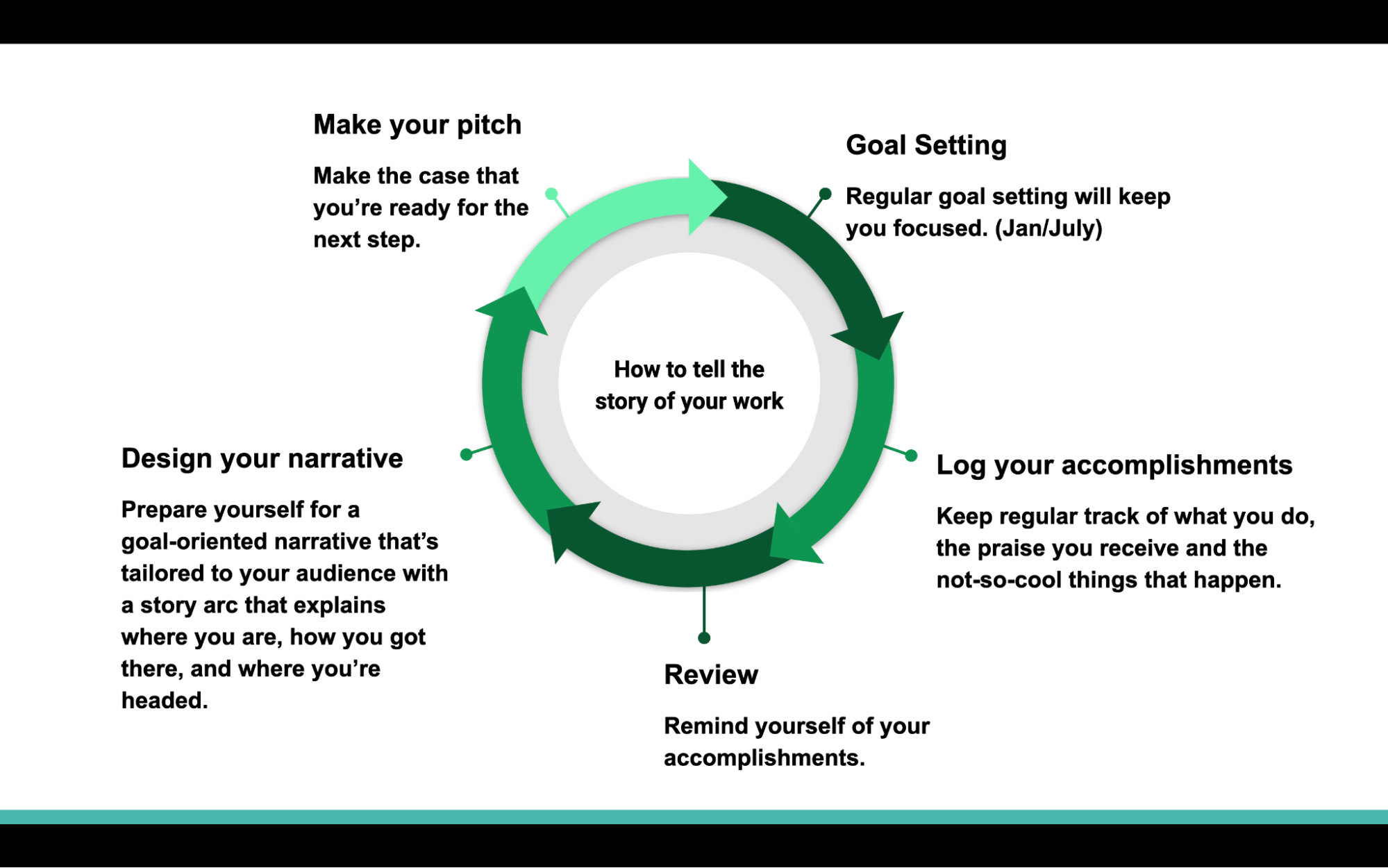Features:
How to tell the story of your work (or, one journalist’s process for career success)
From goal-setting and short reflections to perfecting your personal narrative, here’s a five-step process that keeps you ready

“Work” by Seth W. is licensed under CC BY-SA 2.0.
Journalists love telling other people’s stories–and we’re good at it. But many journalists struggle to tell their own stories, particularly when it comes to their own work. Some of the best news writers I know tell me they struggle to write a cover letter and don’t know how to talk about themselves when they get asked at a conference. This is particularly true for people new to the business and those of us who come from working-class backgrounds.
Over the years, I’ve collected small bits of advice from my mentors like Lego bricks. I’ve assembled those bricks to create a strategy that helps me tell the story of my work. Several of my mentees have been using it effectively for years.
It’s a five-step cycle that repeats and grows with you. Each step is intended to be iterative and be completed fairly quickly (in 15 to 30 minutes). It starts with clear goal-setting, keeping a quick and simple log of what you’re doing, and regular self-reflections on progress. Then, we can use those to develop the narrative that helps us write a bio and cover letter, nail a job interview, and write that elevator pitch for the next journalism conference.
Step 1: Goal setting
It starts with goal setting. Every January and July (give or take) I look at where I am and what I’d like for my life, and I create a mind map with the word “goals" in the center and time-frames jetting off in each direction. I work backward from what I want in retirement. Then, where I want to be in 5 years, in 1 year, and in 3 months. It’s a brainstorming exercise that includes personal and professional goals, and I rarely spend more than 15 to 30 minutes doing it. If it took any longer, I probably wouldn’t stick with it.
Your goals may or may not specifically include a raise or a promotion. Also consider projects you want to do in the coming months and years. What are the skills you want to learn or improve? Starting with goal setting helps me decide why I need to tell my story. It’s the driver.
Step 2: Keep track
At the end of each workday, I spend 10 to 15 minutes writing down what I accomplished that day (I use this Template—feel free to make a copy and use it, or make something similar that works for you!). Some people do it once a week or once a month. This is like exercise: The best one to do is the one you’ll stick with. This part is about gathering data that you can use in any number of ways moving forward.
The important thing is that you track what you’ve accomplished, including the small wins. Remember to track the praise you get, whether it’s a kind email from your audience or a pat on the back from your boss. Keep track of the impact from your work: Did your story end up in a newsletter? Was it quoted at the county board of supervisors meeting? Keep track of that.
Finally, don’t forget to log the unsavory things that happen on the job, too. So many people who are experiencing on-the-job harassment are told to keep track of everything, but often that advice comes months after the problem began. Start documenting BEFORE things get bad.

(fictionalized example from Template)
Step 3: Review
Choose a time frame to review your progress and stick to it. I check on progress toward my goals every month, reviewing my work diary and how I’m spending my time. For me, this is a journaling exercise, but you could also make some short notes, highlights, or make a list. This practice gives me perspective about whether I’m investing time in the ways that I’ve planned and helps me decide whether I need to make an adjustment.
In this review, consider the lessons you’ve learned personally and professionally, think about what you’re most proud of, and what you want to work on. It’s important to remind yourself how you’re doing so you can note your progress and take steps to improve. For me, it’s helped improve my confidence because it forces me to remember what I’ve accomplished—even when progress comes slowly.
Steps 4: Design your narrative
Because you’ve written down your goals and you have plenty of information to remind yourself about what you’ve been up to, you can now design a goal-oriented narrative. This is the outline that helps you update your resume, write a cover letter, or give a verbal pitch on short notice. This is the key step that everything before leads up to, and it starts like any other narrative. As a journalist, you know that good stories include clear framing and a story arc, and they consider the needs of your intended audience.
When you’re applying to a job that already has a clear existing description, your audience has offered you the framing. Present your skills and experiences around what the employer needs. It’s trickier when you’re starting from scratch, but that also frees you to frame your narrative around your own goals. If you’re asking for something from your current employer, make sure you consider and address the ways that you getting the promotion or training budget will also benefit your boss.
Think about the story arc of your career. That means you will assess and clearly state where you are now and the steps you took to get there. Most importantly, what’s next for you? This lines up the story to explain how you’re well positioned for your proposed next steps.
Framing also means reframing. Because you keep track of what you’re doing, you have plenty of examples of things you do well—but they may not always align easily with what you’re wanting to request. For example, I used to teach Spanish before I moved to broadcast journalism. It took a while before I realized that tasks from my past career were truly relevant to my current one. I had to plan and oversee large projects. I had to edit work and give clear and actionable feedback. These are leadership and editing skills. Make sure you’re thinking of ways to frame and reframe your many applicable successes to build to what’s next.
Channel your inner editor and keep your narrative focused on your goal(s). You will have different narratives for different contexts, and you have to cut the irrelevant details. Make sure you are self-aware enough (that’s why we’re keeping track) to know your strengths and your opportunities for growth. Keep your narrative positive and your eye on the prize.

(Visual by Michelle Faust Raghavan)
Steps 5: Write the story and make the pitch
This is the one piece of the process that is mostly on-demand. Use all the steps above to keep your resume up to date, but other kinds of opportunities can come up at any moment. This whole system is designed to make it easier and quicker to be ready as they arise.
Writing the story and making your pitch go hand-in-hand. In the case of a cover letter, they are one and the same, but with luck there will be more in-person pitching to come. In other cases, the written story of your work is the opening number. You probably have to document your work progress, successes, and learnings during an annual or quarterly review that you turn in for your employer. It’s much easier to complete those thankless forms when you already know the narrative of your work and where you want it to take you.
When it’s time to make an in-person pitch, you can start your conversation with the successes and key points from the narrative you’ve already designed. Then use your natural journalistic curiosity and ask lots of relevant questions. You may want to practice your pitch with a friend who can give you tips about your pacing, choice of wording, and body language. Remember your focused narrative, and stay positive and enthusiastic in your approach.
Relationship building and gratitude will take you far
The purpose of this process is to keep you focused and ready so you don’t have to get ready when a great opportunity pops up. When you have a pithy, positive, balanced, honest view of where you are and where you’re going, you’ll be polished when you meet someone new at a journalism conference and just as polished when you are in a job interview process. You’ll be surprised at how helpful it can be in establishing your credibility with new sources and even when you’re making the case to work on the next big project in your newsroom.
When you use this process to apply for work, I want to tell you what I tell my mentees: If you approach a job application as if the only way to win is to get the job, you can easily be disappointed. If you are one in 100 applicants, there’s a 99% chance of losing. But if you approach the application as a chance to show what you can do and begin a relationship, you can’t lose.
Two things that have paid the most dividends in my career: relationship building and gratitude. If you’ve made your pitch, always show your gratitude for people’s time and attention. This helps your relationships grow and it’s just the right thing to do.
Treat every interaction as an opportunity to build a relationship with your boss, colleagues, and your extended network. It’s important to remember that you’ll get much further investing in a professional relationship, rather than a transactional interaction. While you may be able to use parts of your professional narrative when you talk to your colleagues in a meeting or chat with someone at a conference, avoid asking for something every time you interact with your network.
You can use this five-step strategy as-is, or use the building blocks to come up with your own version. The key is that you keep track of your work and your progress. This will help you stay confident, focused, and ready for whatever is coming around the corner.
Credits
-
 Michelle Faust Raghavan
Michelle Faust Raghavan
Michelle Faust Raghavan (they/them) is a John S. Knight Journalism Fellow at Stanford and the founder of Claridad Media, an organization that works with newsrooms to strengthen their relationships with communities. They have worked as a journalist and a journalism coach for well over a decade. Michelle is currently examining best practices to create a culture of belonging for BIPOC journalists in the news industry.



